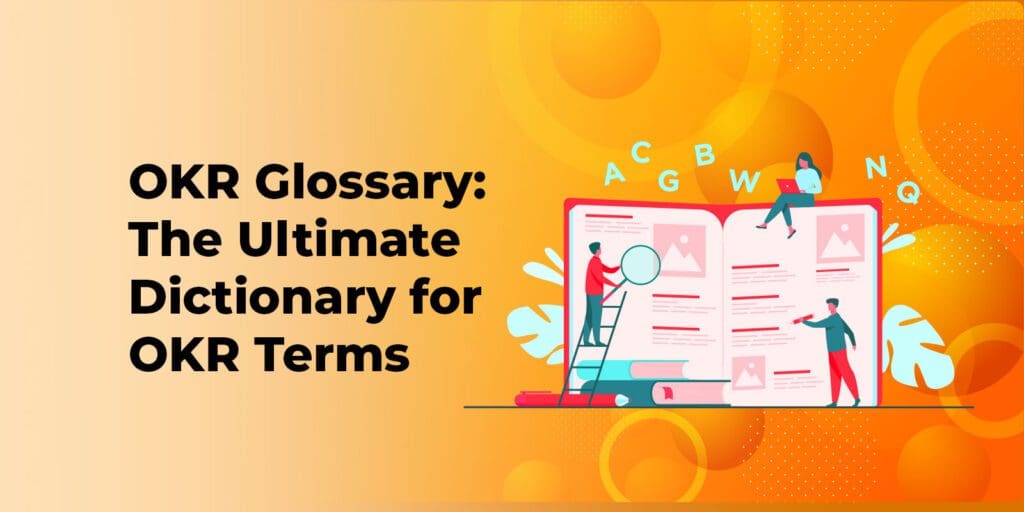Table of Contents
OKR Glossary: The Ultimate Dictionary for OKR Terms
This OKR (Objectives and Key Results) nomenclature will help you understand the world of OKRs. The goal-setting framework of OKR is essential for outlining achievable business goals and tracking their progress.
Use this as a quick-stop guide to refer to important OKR-related terminologies and gain more information about this framework.
What is OKR?
Objectives and Key Results (OKRs):
The ‘O’ stands for Objectives, while the ‘KR’ stands for Key Results. This action-oriented execution framework helps an organisation, team or individual to align with the larger business goals. By working towards the same goals, this framework drives focus, improves employee engagement, and provides transparency.
Common Terms Used in the OKR Universe
Aspirational OKRs
This type of OKR prioritises success and innovation. It forces the team to think creatively and be audacious with their plans and actions. They force teams to stretch and accommodate more ideas and act differently than they usually would. These are called moonshots since just a minimum of 20% achievement is well appreciated and considered a success.
Benchmark
A benchmark is a set standard against which something else is compared. In this case, a key result, KPI (Key Performance Indicator), or metric could be measured against a benchmark. Acting as a point of reference, it can help understand if a company or team is making progress on its goal.
B.H.A.G
Big Hairy Audacious Goals (BHAG) are compelling long-term goals that seem daunting and huge. They bring teams together to form a unifying vision where people are motivated to achieve something challenging. This unique phrase is from Jim Collin’s book, Good to Great.
Bottom-up OKR
This refers to any OKR that is set as a response to an OKR that is outlined at a higher level within an organization. With this bottom-up approach, teams or employees come together to design a statement of purpose or goal. They then attempt to persuade other employees and management from the bottom up.
Cascade
This OKR term refers to the process by which higher-level OKRs are cascading down through an organisation. Associated with top-down management goals, Objectives and Key Results are split into smaller parts and distributed among lower team members. This enables alignment throughout the entire company.
CFRs
This abbreviation means Conversation, Feedback and Recognition, and indicates all the interactions that provide humanness to OKRs. It ensures that OKRs come to life. Introduced by John Doerr, they function as siblings to OKRs happening throughout the entire cycle of an OKR. CFRs ensure that transparency, engagement and accountability are maintained. It happens in in-person meetings, email updates, and so on.
Committed OKRs/Roofshot
This refers to the goals set by an organizational team that must be achieved by them. It is realistic to accomplish and stretches the team wherein there are incremental improvements. These are shorter in duration and usually last during a quarter cycle or two.
Continuous Performance Management:
As an alternative to annual reviews, continuous performance management helps ensure that feedback is given throughout the year continuously. It is done through defined and well-planned quarterly check-ins. Once the OKR is set, it evaluates how it is followed through.
Customer Experience
Also known as CX, customer experience occurs from every interaction a customer has with your business/company. Customer experience can happen from using a company’s product/service, navigating the company’s website, or even talking to a customer support agent. Delivering a good customer experience can hugely impact a business.
Directional Alignment
There are types of OKR alignment: Directional and Explicit. Directional alignment refers to using high-level OKRs as an instrumental guide to creating team OKRs or individual OKRs. They tend to be more “fluid” as opposed to Explicit alignment. One can use OKRs from elsewhere in the organisation to align the team with overall organisational goals.
Equity Pause
This refers to a short pause or step in between the OKR process where individuals and teams confirm that they are being inclusive. This ensures that there are no biases or favouring involved and that everyone gets an equal voice. If the OKRs indicate any biases, this step helps rectify the issue.
Explicit Alignment
This is one of the two types of OKR alignment, Directional and Explicit. Explicit alignment comes in handy during an extreme crisis or when the company needs to go into laser-focus mode to deal with a situation. These are more rigid than directional alignment and force teams to align with company objectives. It derives measurable Key Results from a higher level OKR as the outline for any individual or team Objective.
F.A.C.T.S.
John Doerr, the investor and venture capitalist who introduced OKRs to Google in 1999, calls five major aspects as the OKR Superpowers. These include: 1) Focus, 2) Alignment, 3) Commitment, 4) Tracking, and 5) Stretching.
Feedback Loop
The customer feedback loop is an improvement strategy based on continuous reviews and feedback from customers. It is the constant improvements made from positive or negative feedback. By executing this strategy, the company can improve its products or services while the customers also feel heard and seen.
Individual OKRs
These OKRs differ from personal OKRs in the sense that they are set and committed to by team members/employees who are aligned with the larger departmental & company-wide OKRs. Based on their roles here, they set individual OKRs to ensure they achieve their larger goals.
Key Results
Key Results stand for the abbreviation of the “KR” in OKRs. They outline how to achieve an Objective. Effective KRs are specific, time-bound, and realistic. They are measurable and use words like “Increase” or “Decrease” since they describe outcomes and not activities. Key Results hence track progress towards the Objective and typically range from 1-5 per objective.
KPIs
Key Performance Indicators (KPIs) are quantifiable and can sometimes be used as Key Results within the OKR framework. They help to track metrics for your business and also assist in measuring your organisation’s operations.
Learning OKRs
Learning OKRs are a part of the categories of OKRs, the other two being Aspirational and Committed. This type enables teams to test any hypothesis and is helpful in defining success when the outcome is unclear.
Net Promoter Score (NPS)
NPS is a measure used to gauge customer satisfaction, loyalty, enthusiasm and overall contentment. It is measured by asking just one question that most of us have come across in surveys or towards the end of a website- “On a scale from 0 to 10, how likely are you to recommend this product/company to a friend or colleague?” It is calculated by subtracting the percentage of customers who respond to the NPS question with a 6 or lower (‘detractors’) from the percentage of customers who answer with a 9 or 10 (known as ‘promoters’).
OKR Coach
As the term suggests, an OKR coach is an industry expert who has worked with the framework long enough to teach and guide others. They use their experience to support management and assist teams in using the OKR and CFR methodologies. Their guidance will help with goal-setting and teaching how to craft and implement OKRs. They use their expertise to identify errors and refine OKRs.


OKR Review
OKRs need regular check-ins for optimum results. Since any successful organisation will ensure that they check in on a regular basis with the team and grade quarterly, OKR reviews are part and parcel of the framework. They come naturally in conversations about goals and 1:1 or weekly and quarterly meetings. OKR reviews also help with regular revisions.
OKR Software
With newer technological advancements every day, the development and access to OKR software to is also easier. OKR software refers to any online tool dedicated to helping set, communicate, track, and measure goals and progress within a business. 10xokr is a helpful software that helps turn your objectives into realistic plans!
Parent OKR
These are top-level or higher-order OKRS that guide all teams and give them aspiration and motivation. These are also called Strategic OKRs or Organisational Level OKRs. These inspire the Child OKR (OKRs that are nested or branched under a larger, parent OKR) to achieve its objectives.
Private OKRs
This type of OKR is very confidential and only shared among specific teams or individuals since it has sensitive data.
Sandbagging
This refers to setting goals that underpromise and over-deliver. By settings the standards low, this strategy ensures that the company’s or individual’s expectations are low. It then delivers unanticipated or greater-than-anticipated results to impress them.
Strategic Planning
This refers to an organisation’s comprehensive plan to attain its long-term plans. However, OKRs cannot replace strategic planning but instead align with company strategies for better results during an OKR cycle.
Team OKRs
Created by the team, for the team, of the team, team OKRs are inclusive and involve the entire team to align with company goals. They refer to a collective or shared plan of action and boost teamwork and dedication. Team OKRs are beneficial since individual members contribute equally because they are committed to the team.
Transparent OKRs
All OKRs (except for any private or confidential ones) are transparent since they are openly shared among members of an organisation. Everyone is kept in the loop and focused on the same goals.
Value-Based KR
Also referred to as Outcome-based Key Results (KRs), value-based KRs are the measurement of the value provided to the organisation or to customers. This is result-focused and ensures that the standard of the business is maintained.
Work Plan
OKRs refer to a set of goals that can be utilised to guide any work plan. Work plans are plans, usually outlined step-by-step, to attain a goal like finishing a project or initiative.
This one-stop OKR glossary covers the important words you will come across every day in your OKR journey. It discusses how the OKR tool is beneficial to businesses, especially if one is familiar with the terms associated with it.



